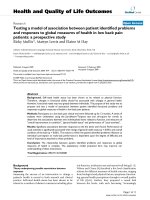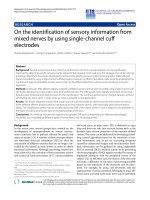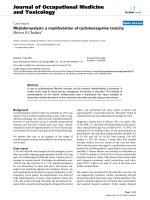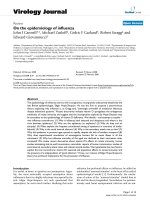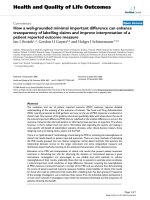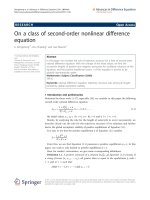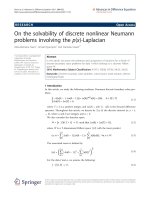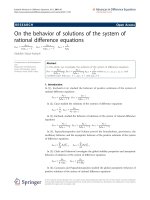Báo cáo hóa học: " On a class of second-order nonlinear difference equation" potx
Bạn đang xem bản rút gọn của tài liệu. Xem và tải ngay bản đầy đủ của tài liệu tại đây (219.03 KB, 9 trang )
RESEARCH Open Access
On a class of second-order nonlinear difference
equation
Li Dongsheng
1*
, Zou Shuliang
1
and Liao Maoxin
2
* Correspondence: lds1010@sina.
com
1
School of Economics and
Management, University of South
China, Hengyang, Hunan 421001,
People’s Republic of China
Full list of author information is
available at the end of the article
Abstract
In this paper, we consider the rule of trajectory structure for a kind of second-order
rational difference equation. With the change of the initial values, we find the
successive lengths of positive and negative semicycles for oscillatory solutions of this
equation, and the positive equilibrium point 1 of this equation is proved to be
globally asymptotically stable.
Mathematics Subject Classification (2000)
39A10
Keywords: rational difference equation, trajectory structure rule, semicycle length;
periodicity, global asymptotic stability
1 Introduction and preliminaries
Motivated by those work [1-17], especially [10], we consider in this paper the following
second-order rational difference equation
x
n+1
=
1+x
k
n
x
l
n−1
+ a
x
k
n
+ x
l
n
−1
+ a
, n = −1, 0, 1,
,
(1:1)
the initial values x
-1
, x
0
Î (0, +∞), a Î (0, +∞) and k, l Î (-∞,+∞).
Mainly, by analyzing the rule for the length of s emicycle to occur successively, we
describe clearly out the rule for the trajectory structure of its solutions and further
derive the global asymptotic stability of positive equilibrium of Equation (1.1).
It is easy to see that the positive equilibrium
¯
x
of Equation (1.1) satisfies
¯
x =
1+
¯
x
k
+
l
+ a
¯
x
k
+
¯
x
l
+
a
.
From this, we see that Equation (1.1) possesses a positive equilibrium
¯
x
=
1
.Inthis
paper, our work is only limited to positive equilibrium
¯
x
=
1
.
Here, for readers’ convenience, we give some corresponding definitions.
Definition 1.1. A positive semicycle of a solution
{x
n
}
∞
n
=−
1
of Equation (1.1) consists of
astringofterms{x
r
, x
r+1
, , x
m
}, all greater than or equal to the equilibrium
¯
x
, with r
≥ -1 and m ≤∞such that
either r = −1 or r > −1 and x
r
−1
<
¯
x
Dongsheng et al. Advances in Difference Equations 2011, 2011:46
/>© 2011 Li et al; licensee Spr inger. This is an Open Access article distributed under the terms of the Creative Commons Attribution
License ( which permits unrestricted use, distribution, and reproduction in any medium,
provided the original work is properly cited .
and
either m = ∞ or m < ∞ and x
m
+1
<
¯
x
.
A negative semicycle of a solution
{
x
n
}
∞
n
=−
1
of Equation (1.1) consists of a string of
terms {x
r
, x
r+1
, , x
m
}, all less than the equilibrium
¯
x
, with r ≥ -1 and m ≤∞such that
either r = −1 or r > −1 and x
r
−1
≥
¯
x
and
either m = ∞ or m < ∞ and x
m
+1
≥
¯
x
.
The length of a semicycle is the number of the total terms contained in it.
Definition 1.2. A solution
{x
n
}
∞
n
=−
1
of Equation (1.1) is said to be eventually positive if
x
n
is eventually greater than
¯
x
=
1
. Asolution
{x
n
}
∞
n
=−
1
of Equation (1.1) is said to be
eventually negative if x
n
is eventually smaller than
¯
x
=
1
.
Definition 1.3. We can divide the solution s of Equation (1.1) into two kinds of types:
trivial ones and nontrivial ones. A solution
{x
n
}
∞
n
=−
1
of Equation (1.1) is said to be even-
tually trivial if x
n
is eventually equal to
¯
x
=
1
; otherwise, the solution is said to be
nontrivial.
If the solution is a nontrivial solution, then we can further divide the solution into two
cases: non-oscillatory solution and oscillatory solution. A nontrivial solution
{x
n
}
∞
n
=−
1
of
Equation (1.1) is regarded as non-oscillatory solution if x
n
is eventually positive or nega-
tive; otherwise, the nontrivial solution is oscillatory.
For the other concepts in this paper, see Refs.[1,2].
2 Trajectory structure rule
The solutions of Equation (1.1) include trivial ones, non-oscillatory ones and oscillatory
ones, and their trajectory structure rule of the solutions is as follows.
2.1 Nontrivial solution
Theorem 2.1. A positive solution
{x
n
}
∞
n
=−
1
of Equation (1.1) is eventually trivial if and
only if
(
x
−1
− 1
)(
x
0
− 1
)
=0
.
(2:1)
Proof. Sufficiency. Assume that Equation (2.1) holds. Then according to Equation
(1.1), we know that the following conclusions are true:
(i) If x
-1
= 1, then x
n
= 1 for n ≥ 1.
(ii) If x
0
= 1, then x
n
= 1 for n ≥ 1.
Necessity. Conversely, assume that
(
x
−1
− 1
)(
x
0
− 1
)
=0
.
(2:2)
Then, we can show x
n
≠ 1foranyn ≥ 1. For the sake of contradiction, assume that
for some N ≥ 1,
x
N
=1and that x
n
=1
f
or an
y
− 1 ≤ n ≤ N − 1.
(2:3)
Clearly,
1=x
N
=
1+x
k
N−1
x
l
N−2
+ a
x
k
N
−1
+ x
l
N
−2
+ a
.
Dongsheng et al. Advances in Difference Equations 2011, 2011:46
/>Page 2 of 9
From this, we can know that
0=x
N
− 1=
(x
k
N−1
− 1)(x
l
N−2
− 1)
x
k
N
−1
+ x
l
N
−2
+ a
,
which implies x
N-1
=1,orx
N-2
= 1. This contradicts with Equation (2.3).
Remark 2.2. Theorem 2.1 actually demonstrates that a positive solution
{x
n
}
∞
n
=−
1
of
Equation (1.1) is eventually nontrivial if (x
-1
-1)(x
0
-1)≠ 0. So, if a solution is a non-
trivial one, then x
n
≠ 1 for any n ≥ -1.
2.2 Non-oscillatory solution
Lemm a 2.3. Let
{x
n
}
∞
n
=−
1
be a positive solution of Equation (1.1) which is not eventually
equal to 1, then the following conclusion is true:
(A) If kl <0,then (x
n+1
- 1)(x
n
- 1)(x
n-1
-1)<0,for n ≥ 0;
(B) If kl >0,then (x
n+1
- 1)(x
n
- 1)(x
n-1
-1)>0,for n ≥ 0;
Proof. First, we consider (A). According to Equation (1.1), we have that
x
n+1
− 1=
(x
k
n
− 1)(x
l
n−1
− 1)
x
k
n
+ x
l
n
−1
+ a
, n =0,1,
.
Considering kl <0,
(
x
n+1
− 1
)(
x
n
− 1
)(
x
n−1
− 1
)
< 0
.
Noting that kl <0,thatisk Î (-∞,0)andl Î (0, +∞), or k Î (0, +∞ -∞, 0), and l Î
(-∞,0),onehas
(x
k
n
− 1)(x
n
− 1) >
0
,
(x
l
n
−1
− 1)(x
n−l
− 1) <
0
,or
(x
l
n
−1
− 1)(x
n−l
− 1) >
0
,
(x
l
n
−1
− 1)(x
n−l
− 1) >
0
.Fromthose,onecangettheresult
easily.
The proof of (B) is similar to (A).
Theorem 2.4. Let kl <0,there exist non-oscillatory solutions of Equation (1.1) with x
-
1
, x
0
Î (0, 1), which must be eventually negative. There do not e xist eventua lly positive
non-oscillatory solutions of Equation (1.1).
Proof. Consider a solution of Equation (1.1) with
x
−1
, x
0
∈
(
0, 1
).
We then know from Lemma 2.3 (A) that 0 <x
n
< 1 for n Î N,whereN Î 1, 2, 3,
So, this solution is just a non-oscillatory solution and furthermore eventually negative.
Suppose that there exists eventually positive non-oscillatory of Equation (1.1). Then,
there exists a positive integer N such that x
n
> 1 for n ≥ N. Thereout, for n ≥ N +1,
(
x
n+1
− 1
)(
x
n
− 1
)(
x
n−1
− 1
)
≥ 0
.
This contradicts Lemma 2.3. So, there do not exist eventually positive non-oscillatory
of Equation (1.1), as desired.
From Lemma 2.3 (B), we can get the result as follows, also.
Theorem 2.5. Let kl >0,there exist non-oscillatory solutions of Equation (1.1) with x
-
1
, x
0
Î (1, +∞), which m ust be eventually positive. There do not exist eventually nega-
tive non-oscillatory solutions of Equation (1.1).
Dongsheng et al. Advances in Difference Equations 2011, 2011:46
/>Page 3 of 9
2.3 Oscillatory solution
Theorem 2.6. Let kl <0,and
{x
n
}
∞
−
1
be a strictly oscillatory of Equation (1.1), then the
rule for the lengths of positive and negative semicycles of this solution to occur succes-
sively is , 2
+
,1
-
,2
+
,1
-
,
Proof. By Lemma 2.3, one can see that the lengt h of a negative semicycle is at most
3, and a positive semicycle is at most 2. On the basis of the strictly oscillatory charac-
ter of the solution, we see that, for some integer p ≥ 0, one of the follow ing 32 c ases
must occur:
case 1: x
p
<1,x
p+1
<1;
case 2: x
p
>1,x
p+1
<1;
case 3: x
p
<1,x
p+1
>1;
case 4: x
p
>1,x
p+1
>1.
case 1 cannot occur. Otherwise, the solution is a non-oscillatory solution of Equa-
tion (1.1).
If Case 2 occurs, it follows from Lemma 2.3 that x
p+2
>1,x
p+3
>1,x
p+4
<1,x
p+5
>
1, x
p+6
>1,x
p+7
<1,x
p+8
>1,x
p+9
>1,x
p+10
< 1,
This means that rule for the lengths of positive and negative semicycles of the solu-
tion of Equation (1.1) to occur successively is , 2
+
,1
-
,2
+
,1
-
, The proof for other
cases, except Case 1, is completely similar to that of Case 2. So, the proof for this theo-
rem is complete.
Theorem 2.7. Let kl >0,and
{x
n
}
∞
−
1
be a strictly oscillatory of Equation (1.1), then the
rule for the lengths of positive and negative semicycles of this solution to occur succes-
sively is , 1
+
,2
-
,1
+
,2
-
,
The proof of theorem (2.7) is similar to that of theorem (2.6).
3 Local asymptotic stability and global asymptotic stability
Before stating the oscillation and non-oscillation of solutions, we need the following
key lemmas. For any integer a, denote N
a
={a, a + 1, ,}.
3.1 Four Lemmas
Lemma 3.1. Let k Î (0, 1], and
{x
n
}
∞
n
=−
1
be a positive solution of Equation (1.1) which is
not eventually equal to 1, then the following conclusions are valid:
(a) (x
n+1
- x
n
)(x
n
-1)<0,for n ≥ 0;
(b) (x
n+1
- x
n-1
)(x
n-1
-1)<0,for n ≥ 0.
Proof. First, we consider (a). From Equation (1.1), we obtain
x
n+1
− x
n
=
1 − x
k+1
n
+ x
l
n−1
x
n
(x
k−1
n
− 1) + a(1 − x
n
)
x
k
n
+ x
l
n
−1
+ a
,
From k Î (0, 1] and
{x
n
}
∞
n
=−
1
not eventually equal to 1, one can see that
(1 − x
k+1
n
)(1 − x
n
) > 0, (1 − x
1−k
n
)(1 − x
n
) ≥ 0, x
k
n
+ x
l
n
−1
> 0
.
This teaches us that (x
n+1
- x
n
)(1 - x
n
)>0,n = 0, 1, That is to say, (x
n+1
- x
n
)(x
n
-
1) < 0, n = 0, 1, So, the proof of (a) is complete.
Dongsheng et al. Advances in Difference Equations 2011, 2011:46
/>Page 4 of 9
Second, one investigates (b). From Equation (1.1), one has
x
n+1
− x
n−1
=
1 − x
k
n
x
n−1
+ x
l
n−1
(x
k
n
− x
n−1
)+a(1 − x
n
)
x
k
n
+ x
l
n
−1
+ a
,
(3:1)
From Equation (1.1), one gets
1 − x
n
x
1
k
n−1
=
x
k
n−1
1 − x
1
k
2
n−1
x
k
n
−1
+ x
l
n
−2
+ a
,
(3:2)
According to k Î (0, 1] and
{x
n
}
∞
n
=−
1
not eventually equal to 1, one arrives at
1 − x
1
k
2
n−1
(1 − x
n−1
) ≥ 0
.
(3:3)
From Equations (3.2) and (3.3), we know
1 − x
n
x
1
k
n−1
(1 − x
n−1
) > 0
.So,wecan
get immediately
1 − x
k
n
x
n−1
(1 − x
n−1
) > 0
.
(3:4)
From Equation (1.1), one can have
x
n
− x
1
k
n−1
=
x
k+l
n−1
1 − x
1
k
2
n−1
x
k
n
−1
+ x
l
n
−2
+ a
,
(3:5)
According to k Î (0, 1] and
{x
n
}
∞
n
=−
1
not eventually equal to 1, one arrives at
1 − x
1
k
2
n−1
(1 − x
n−1
) ≥ 0
.
(3:6)
From Equations (3.5), (3.6), we can obtain that
x
n
− x
1
k
n−1
(1 − x
n−1
) >
0
, i.e.,
x
k
n
− x
n−1
(1 − x
n−1
) > 0
.
(3:7)
By virtue of Equations (3.1), (3.4), (3.7), we see that (b) is true.
The proof for Lemma (3.1) is complete.
Lemma 3.2. Let
{x
n
}
∞
n
=−
1
be a positive solution of Equation (1) which is not eventually
equal to 1, then (x
n+1
- x
n-2
)(x
n-2
-1)<0,for n ≥ 1.
Proof. By virtue of Equation (1.1), one gets
x
n+1
− x
n−2
=
(1 − x
k
n
x
n−2
)+(x
k
n
− x
n−2
)x
l
n−1
+ a(1 − x
n−2
)
x
k
n
+ x
l
n
−1
+ a
, n =0,1,
.
(3:8)
By virtue of Equation (1.1), one obtains that
x
n−1
− x
1
k
2
n−2
=
1 − x
k
3
+1
k
2
n−2
+ a
1 − x
1
k
2
n−2
+ x
l
n−3
x
k
n−2
1 − x
1
k
3
n−2
x
k
n
−2
+ x
l
n
−
3
+ a
.
(3:9)
Dongsheng et al. Advances in Difference Equations 2011, 2011:46
/>Page 5 of 9
According to k Î (0, 1] and
{x
n
}
∞
n
=−
1
not eventually equal to 1, we get
1 − x
k
3
+1
k
2
n−2
(1 −x
n−2
) > 0,
1 − x
1
k
2
n−2
(1 −x
n−2
) > 0,
1 − x
1
k
3
n−2
(1 −x
n−2
) > 0
.
So,
x
n−1
− x
1
k
2
n−2
(1 − x
n−2
) > 0
.
(3:10)
That is
x
k
n−1
− x
1
k
n−2
(1 − x
n−2
) > 0
.
(3:11)
By virtue of Equation (1.1), we can know
1 − x
n
x
1
k
n−2
=
x
k
n−1
− x
1
k
n−2
+ x
l
n−2
1 − x
k+
1
k
n−1
+ a
1 − x
1
k
n−2
x
k
n
−1
+ x
l
n
−2
+ a
.
(3:12)
Utilizing (3.11),(3.12), adding
1 − x
k+
1
k
n−1
(1 − x
n−2
) >
0
,
1 − x
1
k
n−2
(1 − x
n−2
) >
0
when k Î (0, 1], we know the following is true
1 − x
n
x
1
k
n−2
(1 − x
n−2
) > 0
.
So,
1 − x
k
n
x
n−2
(1 − x
n−2
) > 0
.
(3:13)
Similar to (3.13), we know this is true
x
n
− x
1
k
n−2
(1 − x
n−2
) > 0
.
So,
x
k
n
− x
n−2
(1 − x
n−2
) > 0
.
(3:14)
From (3.8),(3.13)and (3.14), one obtains that the following is true
(
x
n
− x
n−2
)(
1 − x
n−2
)
> 0
.
This shows Lemma (3.2) is true.
Lemma 3.3. Let x
-1
, x
0
Î (0, 1), then the following conclusions are true:
(a) If l >0and -1 <k <0or l <0and 0<k <1, then (x
n+1
- x
n
)<0,for n ≥ 0;
(b) If k >0and -1 <l <0or k <0and 0<l <1,then (x
n+1
- x
n-1
)<0,for n ≥ 0.
The proof of lemma (3.3) can be completed by Equation (1.1), theorem 2.4 and prop-
erties of power function easily.
Lemma 3.4. Let x
-1
, x
0
Î (1, ∞), then the following conclusions are true:
Dongsheng et al. Advances in Difference Equations 2011, 2011:46
/>Page 6 of 9
(a) If l >0and 0<k <1or l <0and -1 <k <0,then (x
n+1
- x
n
)<0,for n ≥ 0;
(b) If k >0and 0<l <1or k <0and -1 <l <0,then (x
n+1
- x
n-1
)<0,for n ≥ 0.
The proof of lemma (3.4) can be completed by Equation (1.1), theorem 2.5 and prop-
erties of power function easily.
First, we consider the local asymptotic stability for unique positive equilibrium point
¯
x
of Equation (1.1). We have the following results.
3.2 Local asymptotic stability
Theorem 3.5. The positive equilibrium point of Equation (1.1) is locally asymptotically
stable.
Proof. The linearized equation of Equation (1.1) about the positive equilibrium point
¯
x
is
y
n+1
=0·
y
n
+0·
y
n−1
, n =0,1,
,
and so it is clear from the paper [[2], R emark 1.3.7] that the positive equilibrium
point
¯
x
of Equation (1.1) is locally asymptotically stable. The proof is complete.
We are now in a position to study the global asymptotically stability of positive equi-
librium point
¯
x
.
3.3 Global asymptotic stability of oscillatory solution
Theorem 3.6. The positive equilibrium point of Equation (1.1) is globally asymptoti-
cally stable when k Î (0, 1] and l Î (0, +∞).
Proof We must prove that the positive equilibrium point
¯
x
of Equation (1.1) is both
locally asymptotically stable and globally attractive. Theorem 3.5 has shown the local
asymptotic stability of
¯
x
. Hence, it remains to verify that every positive solution
{x
n
}
∞
n
=−
1
of Equation (1.1) converges to
¯
x
as n ® ∞. Namely, we want to prove
lim
n
→
∞
x
n
=
¯
x =1
.
(3:15)
Consider now {x
n
} to be non-oscillatory about the positive equilibrium point
¯
x
of
Equation (1.1). By virtue of Lemma 3.1(a), it follows that the solution is monotonic
and bounded. So, lim
n®∞
x
n
exists and is finite. Taking limits on both sides of Equa-
tion (1.1), one can easily see that (3.15) holds.
Now let {x
n
} be strictly oscillatory about the positive equilibrium point of Equation
(1.1). By virtue of Theorem 2.6, one understands that the rule for the lengths of posi-
tive and negative semicycles occurring successively is , 2
+
,1
-
,2
+
,1
-
,2
+
,1
-
, For
simplicity, for some nonnegative integer p,wedenoteby{x
p
, x
p+1
}
+
the terms of a
positive semicycle of length two, followed by {x
p+2
}
-
, a negative semicycle with semi-
cycle length one, then a positive semicycle of l ength two and a negative semicycle of
length one, and so on. Namely, the rule for the lengths of positive and negative semi-
cycles to occur successively can be periodically expressed as follows:
{x
p
+3n
, x
p
+3n+1
}
+
, {x
p
+3n+2
}
−
, {x
p
+3n+3
, x
p
+3n+4
}
+
, {x
p
+3n+5
}
−
, n =0,1,2,
.
Lemma (3.1) (a), (b) and Lemma (3.2) teaches us that the following results are true:
(A) x
p+3n
>x
p+3n+1
>x
p+3n+3
>x
p+3n+4
, n = 0, 1, 2,
(B) x
p+3n+2
<x
p+3n+5
<x
p+3n+8
, n = 0, 1, 2,
Dongsheng et al. Advances in Difference Equations 2011, 2011:46
/>Page 7 of 9
So, from (A) one can see that
{x
p
+3n
}
∞
n=
0
is decreasing with lower bound 1. So, the
limit S = lim
n®∞
x
p+3n
exists and is finite.
Furthermore, From (A) one can further obtain
S = lim
n
→
∞
x
p+3n+
1
Similarly, by (B) one can see that
{x
p
+3n+2
}
∞
n=
0
is increasing with upper bound 1. So,
the limit T = lim
n®∞
x
p+3n+2
exists and is finite.
Now, it suffices to prove S = T =1.
Noting that
x
p+3n+2
=
1+x
k
p+3n+1
x
l
p+3n
+ a
x
k
p
+3n+1
+ x
l
p
+3n
+ a
,
(3:16)
x
p+3n+3
=
1+x
k
p+3n+2
x
l
p+3n+1
+ a
x
k
p
+3n+2
+ x
l
p
+3n+1
+ a
,
(3:17)
Taking limits on both sides of the Equations (3.16) and (3.17), respectively, we get
T =
s
k
+
l
+1+a
s
k
+
s
l
+
a
,
(3:18)
S =
s
k
+ T
l
+1+a
s
k
T
l
+
a
,
(3:19)
From this one can see S = 1. A gain, by Equation (3.18), we have T = 1, too. These
show that (3.15) is true. The proof for Theorem 3.6 is complete.
Theorem 3.7. The positive equilibrium point of Equation (1.1) is globally asymptoti-
cally stable when k Î (0, 1] and l Î (-∞, 0).
The proof of theorem 3 .7 is similar to that of theorem 3.6 by virtue of theorem 3.5,
theorem 2.7, Lemma (3.1), Lemma (3.2) and Equation (1.1).
3.4 Global asymptotic stability of non-oscillatory solution
Theorem 3.8. The positive equilibrium point of Equation (1.1) is globally asymptoti-
cally stable when x
-1
, x
0
Î (0, 1) and one of the following conditions is satisfied:
(a) -1 <k <0and l >0;
(b) 0<k <1and l <0;
(c) k >0and -1 <l <0;
(d) k <0and 0<l <1.
The proof of theorem 3 .8 is similar to that of theorem 3.6 by virtue of theorem 2.4,
theorem 3.5, Lemma (3.3) and Equation (1.1).
Theorem 3.9. The positive equilibrium point of Equation (1.1) is globally asymptoti-
cally stable when x
-1
, x
0
Î (1, +∞) and one of the following conditions is satisfied:
(a) -1 <k <0and l <0;
(b) 0<k <1and l >0;
(c) k <0and -1 <l <0;
Dongsheng et al. Advances in Difference Equations 2011, 2011:46
/>Page 8 of 9
(d) k >0and 0<l <1.
The proof of theorem 3 .9 is similar to that of theorem 3.6 by virtue of theorem 2.5,
theorem 3.5, Lemma (3.4) and Equation (1.1).
Acknowledgements
The authors would like to thank the referees for giving useful suggestions and comments for the improvement of this
paper. This research is supported by Social Science Foundation of Hunan Province of China (Grant no. 2010YBB287),
Science and Research Program of Science and Technology Department of Hunan Province (Grant no.2010FJ3163,
2011ZK3066).
Author details
1
School of Economics and Management, University of South China, Hengyang, Hunan 421001, People’s Republic of
China
2
School of Mathematics and Physics, University of South China, Hengyang, Hunan 421001, People’s Republic of
China
Authors’ contributions
All authors carried out the proof. All authors conceived of the study and participated in its design and coordination.
All authors read and approved the final manuscript.
Competing interests
The authors declare that they have no competing interests.
Received: 31 January 2011 Accepted: 26 October 2011 Published: 26 October 2011
References
1. Kulenovic, MRS, Ladas, G: Dynamics of Second Order Rational Difference Equations, with Open Problems and
Conjectures. Chapman and Hall/CRC, London (2002)
2. Amleh, AM, Georgia, DA, Grove, EA, Ladas, G: On the recursive sequence
x
n+1
= α +
x
n−1
x
n
. J Math Anal Appl. 233,
790–798 (1999). doi:10.1006/jmaa.1999.6346
3. Agarwal, RP: Difference Equations and Inequalities: Theories, Methods and Applications. Marcel Dekker Inc, New York,
NY, USA, 2 (2000)
4. Kocic, VL, Ladas, G: Global behavior of nonlinear difference equations of higher order with applications. Kluwer
Academic Publishers, Dordrecht (1993)
5. Li, X, Zhu, D: Global asymptotic stability in a rational equation. J Differ Equ Appl. 9(9), 833–839 (2003). doi:10.1080/
1023619031000071303
6. Li, X, Zhu, D: Global asymptotic stability of a nonlinear recursive sequence. Appl Math Lett. 17(7), 833–838 (2004).
doi:10.1016/j.aml.2004.06.014
7. Li, X: Qualitative properties for a fourth order rational difference equation. J Math Anal Appl. 311(1), 103–111 (2005).
doi:10.1016/j.jmaa.2005.02.063
8. Xi, H, Sun, T: Global behavior of a higher-order rational difference equation. Adv Differ Equ 2006, 7 (2006). Article ID
27637
9. Rhouma, MB, El-Sayed, MA, Khalifa, AK: On a (2, 2)-rational recursive sequence. Adv Differ Equ. 2005(3), 319–332 (2005).
doi:10.1155/ADE.2005.319
10. Yang, X, Cao, J, Megson, GM: Global asymptotic stability in a class of Putnam-type equations. Nonlinear Anal. 64(1),
42–50 (2006). doi:10.1016/j.na.2005.06.005
11. Sun, T, Xi, H: Global asymptotic stability of a higher order rational difference equation. J Math Anal Appl. 330, 462–466
(2007). doi:10.1016/j.jmaa.2006.07.096
12. Sun, T, Xi, H: Global attractivity for a family of nonlinear difference equations. Appl Math Lett. 20, 741–745 (2007).
doi:10.1016/j.aml.2006.08.024
13. Sun, T, Xi, H, Han, C: Stability of Solutions for a Family of Nonlinear difference Equations. Adv Diff Equ 2008,1–6 (2008).
Article ID 238068
14. Sun, T, Xi, H, Wu, H, Han, C: Stability of Solutions for a family of nonlinear delay difference equations. Dyn Cont Discret
Impuls Syst. 15, 345–351 (2008)
15. Sun, T, Xi, H, Xie, M: Global stability for a delay difference equation. J Appl Math Comput. 29(1), 367–372 (2009).
doi:10.1007/s12190-008-0137-1
16. Xi, H, Sun, T: Global behavior of a higher order rational difference equation. Adv. Diff. Equ. 2006,1–7 (2006). Article ID
27637
17. Sun, T, Xi, H, Chen, Z: Global asymptotic stability of a family of nonlinear recursive sequences. J Diff Equ Appl. 11,
1165–1168 (2005). doi:10.1080/10236190500296516
doi:10.1186/1687-1847-2011-46
Cite this article as: Dongsheng et al.: On a class of second-order nonlinear difference equation. Advances in
Difference Equations 2011 2011:46.
Dongsheng et al. Advances in Difference Equations 2011, 2011:46
/>Page 9 of 9
